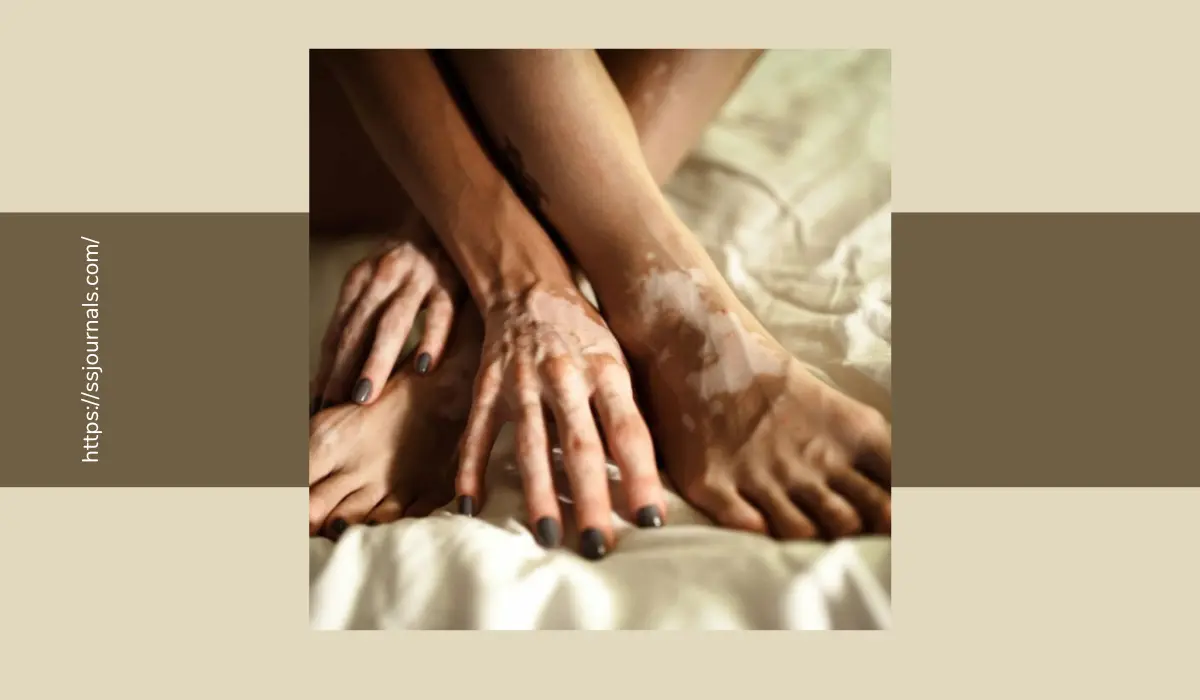Vitiligo is a condition that challenges the way we perceive skin, affecting countless individuals across the globe. In this article, we’ll embark on a journey to explore vitiligo more intimately, delving into its different forms, what might cause it, and the various paths people take to manage and even embrace it. By shedding light on this condition, we aim to promote empathy, support, and acceptance for those who bear its distinctive marks.
What Exactly Is Vitiligo?
Vitiligo is not just a dermatological condition; it’s a unique expression of individuality. It’s marked by the gradual loss of skin pigmentation, leading to the emergence of intriguing, unpigmented white patches. These patches can surface anywhere on the body, coming in diverse sizes and shapes. The condition unfolds as melanocytes, the creative cells behind skin pigment (melanin), either slow down or are sadly obliterated.

Varieties of Vitiligo
Vitiligo doesn’t adhere to a single script it has many acts. Here are its different forms:
- Generalized Vitiligo: Think of this as the “classic” form. It unveils its mysteries symmetrically, with white patches appearing on both sides of the body. These patches often make their grand entrance on the hands, feet, and face.
- Segmental Vitiligo: This variety showcases its flair by affecting only one area or segment of the body. It’s like a guest artist that joins the performance early and stabilizes, ceasing further expansion.
- Focal Vitiligo: Focal vitiligo is like the artistic brush strokes of a painter, scattering white patches on various parts of the canvas that is the human body.
- Mucosal Vitiligo: Sometimes, the condition dares to express itself within the confines of the mouth, nose, and genitalia. It paints a unique portrait of these sensitive areas.
- Universal Vitiligo: A rare and audacious type, universal vitiligo affects nearly the entire body, leaving only a few small islands of pigmented skin as proof of its journey.
Unpacking The Causes
The true genesis of vitiligo remains an enigmatic tale, with many contributing factors:

- Autoimmune Adventures: In one storyline, vitiligo may be an autoimmune story, where the body’s immune system takes a misguided detour and begins to attack and dismantle melanocytes. This is the autoimmune theory.
- Genetic Mysteries: Genetic factors also play their part in this drama. If a family member carries this condition, the family tree might sway in the direction of vitiligo, hinting at genetic predisposition.
- Environmental Elements: Outside influences are no strangers to this narrative. Exposure to certain chemicals or traumatic life events may be seen as instigators, stirring the plot or intensifying the symptoms. Stressful times in one’s life can be the scene of these climactic turns.
- Neurochemical Notions: Some researchers suggest a neurochemical connection. In this intriguing subplot, it’s implied that neural factors may help shape the story.
Also, Read: The Benefits Of Vitamin C For Skin Health
Navigating The Journey: Treatment Options
While there’s no final curtain call for vitiligo, there are numerous options available to help manage and soften its presence on the stage:
- Topical Corticosteroids: Think of these as the soothing balm for inflamed scenes. These creams or ointments reduce inflammation and temper the immune response, helping to rekindle some lost pigmentation. They work wonders on smaller, localized areas of the skin.
- Topical Calcineurin Inhibitors: These medications are the cast members that step in to modulate the immune response and assist with skin repigmentation. They’re especially adept at handling facial and genital vitiligo scenes.
- Psoralen plus Ultraviolet A (PUVA) Therapy: This treatment brings together medication (psoralen) and UVA light to stimulate melanocyte activity and breathe life back into the depigmented areas. It’s a coordinated effort, administered in a medical setting.
- Narrowband Ultraviolet B (NB-UVB) Therapy: This is another type of light therapy that shines a focused beam of UVB light on the scene. It’s known to be effective for reigniting the skin’s hue and can be administered both in a clinic or with a home unit.
- Excimer Laser: Here, we have a precision tool, like an artist’s brush. The excimer laser emits a specific UVB wavelength, targeting specific patches with accuracy and intent.
- Surgical Options: In cases where the story seems to have reached an impasse, surgical procedures step in to offer new hope. These include:
- Skin Grafting: In this procedure, a healthy patch of pigmented skin is transferred to the area with vitiligo, helping restore the balance of colors.
- Melanocyte Transplantation: In a groundbreaking approach, melanocytes are cultivated in a laboratory and then transplanted into depigmented areas, like an artistic collaboration between science and skin.
- Tattooing (Micropigmentation): Specialized tattoos are employed to implant pigments into the depigmented areas, creating a harmonious blend with the surrounding skin.
Living With Vitiligo
Vitiligo’s unique artistic expression can be a rollercoaster of emotions, leading those who bear it to experience moments of self-consciousness, fluctuating self-esteem, and social isolation. Offering support and understanding to individuals with vitiligo can be a powerful force in their journey.
Coping Strategies
- Self-acceptance: Everybody has an exclusive beauty, just in the same way every character in a story is important. Self-acceptance can be likened to having the courage to play a leading role in one’s own life. Vitiligos have a uniqueness that they must appreciate, as their value is not just in their color.
- Seeking Support: A strong support system is like the loyal sidekicks in every hero’s journey. Joining support groups or seeking professional help can be a lifeline. It’s like having a trusted confidant to help navigate the emotional ups and downs that come with vitiligo.
- Sun Protection: Just like the way armor protects a soldier from injury, sun protection acts as such for the skin of the body. Skin affected by depigmentation burns easily in the sun, so using sunscreen and putting on protective clothes represent reasonable measures for protecting the sun-affected skin. As it were, it adds a shield on top of a shield when fighting with nature’s fury.
- Awareness and Advocacy: Raising awareness about vitiligo is akin to becoming a storyteller, sharing the unique narrative of this condition. It’s like shedding light on a complex character in the world of dermatology. Advocacy efforts are like the heroes of change, working towards a society that’s more supportive, inclusive, and understanding.
Conclusion
Vitiligo is more than a condition; it’s a journey that involves discovering oneself and acquiring strength. It has, nevertheless, proved to be an affirmation of the indomitable nature of the human species, witty enough to fight back. This knowledge will help people understand different types of vitiligo, their origins, possible cures, and mechanisms of coping with these diseases.
Just remember that you are not alone if you or someone you know has been traveling with this condition of vitiligo. See a dermatologist for appropriate treatment that will be custom-made for you. It might take some twists and turns, but the journey is towards self-acceptance as a strong person with a better insight into what it means to be human. Vitiligo is much more than a disease; it’s a story about coping with adversity. Enjoy the ride, as it’s tailor-made just for you.

